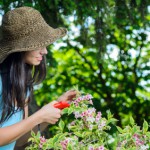 It’s January. It’s the perfect time to start thinking about how to prepare your garden and plants for the bloom of spring. Although the ground lay quiet, cold and dormant, there’s plenty to do to make sure your garden achieves optimum growth.
It’s January. It’s the perfect time to start thinking about how to prepare your garden and plants for the bloom of spring. Although the ground lay quiet, cold and dormant, there’s plenty to do to make sure your garden achieves optimum growth.
Here are a few helpful hints you can do between now and March for that perfect garden:
Trim and Prune – If you haven’t already, this is an ideal time to prune trees, rose bushes and shrubs. Cut off all dead heads and dead leaves to make room for new growth. Don’t be afraid to cut back so there is nothing left but branches, if necessary. Trees, especially crepe myrtles will grow back if properly tended.
NOTE: Rose bushes should be pruned no later than February 14.
Plan Your Plot – If you are planning to plant new seeds, plan what you want in advance. There’s always a chance that what you intend to grow is a cold-weather plant and needs to be planted now. Plants such as these would include some vegetables and herbs like cauliflower, cabbage, onions, parsley, chives, sage, cilantro and thyme (among others).
Turn the Soil – If the soil has thawed in your area, it’s a good idea to turn it. This will start to break up the frozen layers, as well as exposing insect eggs and larvae for the birds to take care of. In addition, if it freezes again, it will kill any exposed pests.
Eliminate Pests – As mentioned above, turning the soil will definitely help to prevent pest issues, come spring. However, on a warm day I recommend walking around your property and looking for signs of any damage. If you take care of the issues now, your garden will have a much better chance of thriving. Research pest control products you can use in the spring and have them purchased and ready to go before you begin planting.
Start Seeds Indoors – There are many advantages to starting some seeds indoors. If you begin harvesting earlier, your seedlings could end up stronger and healthier overall. To get started, fill a clean container, that drains well. You can punch holes in something like an egg crate, for instance. Plant the seeds according to package directions and place the container inside a large, loose, transparent plastic bag for humidity and warmth. Add fertilizer once the seedling has four or more leaves. Cool season crops such as broccoli, cabbage, celery, leek and a variety of lettuces can all start indoors from seed in the winter months.